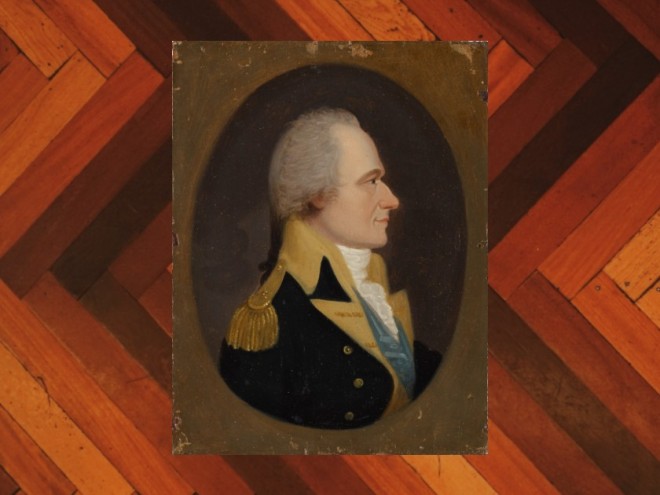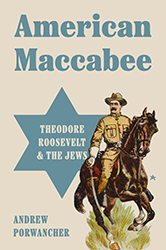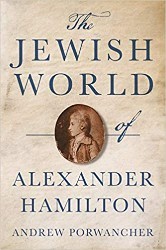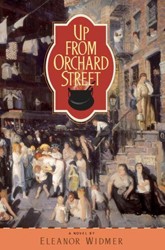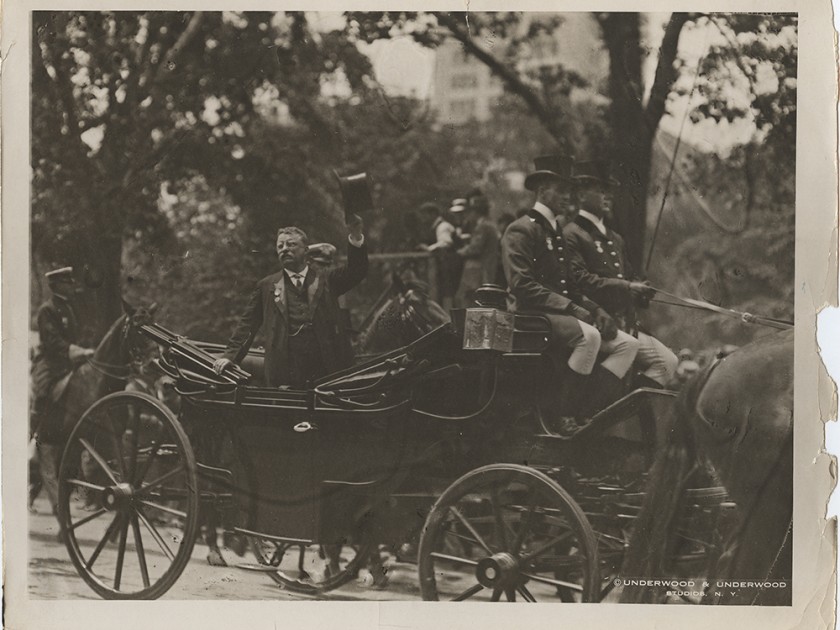
Theodore Roosevelt Riding in a Carriage along Fifth Ave, in New York City, June 18, 1910
From the Doris A. and Lawrence H. Budner Theodore Roosevelt Collection, DeGolyer Library, Southern Methodist University
The question of Jewish belonging in America has reached fresh urgency as the forces of antisemitism turn newly violent. In April, a would-be assassin set fire to the governor’s mansion in Harrisburg, Pennsylvania where Josh Shapiro and his family slept following a Passover seder. In May, two Israeli Embassy staffers were savagely gunned down outside the Capital Jewish Museum in Washington, D.C. And in June, a man tossed Molotov cocktails at a peaceful demonstration supporting Israeli hostages in Colorado. These blood-soaked assaults on Jews feel more reminiscent of Old World hatred than the New World haven that America has long provided for the Jewish community. And the current spike in violence takes place against a backdrop of college campus controversies from the left and conspiracy theories from the right that threaten to push Jews to the periphery of American society. How should we respond to this challenge? In researching my new book, I uncovered a powerful answer from an unexpected source: Theodore Roosevelt.
When Roosevelt was the young police commissioner of New York in 1895, concerned Jews beseeched him about a troubling development. A notorious German antisemite, Hermann Ahlwardt, was preparing to give a lecture on the Lower East Side of Manhattan, the beating heart of the American Jewish community. These concerned Jews pleaded with Roosevelt to ban Ahlwardt’s address or, if nothing else, to refuse him a police detail. But Roosevelt knew that acceding to these demands would mean undermining Ahlwardt’s First Amendment rights. And even if censorship were a legally available option, silencing Ahlwardt would only turn him into a victim. “The proper thing to do was to make him ridiculous,” Roosevelt later recalled in his autobiography. And so Roosevelt resolved to furnish Ahlwardt with a security detail comprised solely of Jewish policemen.
Roosevelt ordered a deputy to bring him upwards of twenty Jewish officers. “Take those who have the most pronounced Hebrew physiognomy,” Roosevelt instructed him. “The stronger their ancestral marking, the better.” Once the Jewish policemen were gathered before him, Roosevelt explained why he had summoned them. “Now, I am going to assign you men to the most honorable service you have ever done — the protection of an enemy and the defense of religious liberty and free speech in the chief city of the United States,” he declared. “You all know who and what Dr. Ahlwardt is. I am going to put you in charge of the hall where he lectures, and hold you responsible for perfect good order there throughout the evening.” Roosevelt explained that the real object of their protection was not Ahlwardt’s message of hate but rather freedom of conscience. Roosevelt elaborated, “I have no more sympathy with Jew-baiting than you have. But this is a country where your people are free to think and speak and act as they choose in religious matters, as long as you do not interfere with the peace and comfort of your neighbors, and Dr. Ahlwardt is entitled to the same privilege.” Guarding Ahlwardt was not a burden but an opportunity, Roosevelt insisted: “It should be your pride to see that he is protected … that will be the finest way of showing your appreciation of the liberty you yourselves enjoy under the American flag.”
We would be wise to remember today what Roosevelt well knew back then: the best way to combat antisemitism, for Jew and non-Jew alike, is to reaffirm our commitment to the values of liberal democracy.
At the Cooper Union, an iconic venue on the Lower East Side, some 150 people congregated on the night of Ahlwardt’s oration. These attendees fell roughly into three categories of equal size: Jewish members of Roosevelt’s force serving as Ahlwardt’s detail, Jewish civilians intent on heckling, and a smattering of others who were ostensibly agreeable to Ahlwardt’s ideas. It did not take long for Ahlwardt to strike an antisemitic note, eliciting a loud reaction from the Jewish civilians. As The New York Times recorded, “His words were drowned in a perfect Niagara of hisses and cries.”
Roosevelt’s Jewish officers confronted only one significant disruption. When Ahlwardt derided Jews for their “odious peculiarities,” a Lower East Sider launched an egg at the speaker. “A nice white egg performed a graceful parabola through the air in the direction of Herr Ahlwardt’s smiling face,” the Times recounted. “He danced aside, with a degree of agility not indicated by his [rotund] form, and the egg smashed and spluttered on the chair behind him.” Officers took hold of the egg-tossing culprit and hauled him to a local police station.
The whole affair became an enduring source of pride for Theodore Roosevelt. He even wrote about it years later in his autobiography, remembering how “Ahlwardt delivered his violent harangues against the men of Hebrew faith, owing his safety to the fact that he was scrupulously protected by men of the very race which he was denouncing.” The tableau of Jews safeguarding Ahlwardt did more to discredit his bilious creed than muzzling him would have.
We would be wise to remember today what Roosevelt well knew back then: the best way to combat antisemitism, for Jew and non-Jew alike, is to reaffirm our commitment to the values of liberal democracy. That means respecting the speech freedoms of campus protestors who seek to inflame tensions. That means ensuring the physical safety of antisemitic agitators. That means affording due process rights to those who commit atrocities against Jewish victims. The power of democracy to fight Jew-hatred is never clearer than when its liberal principles are extended to the very bigots who would deny the same to Jews.
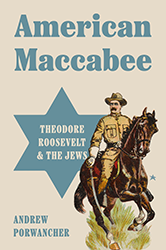
American Maccabee: Theodore Roosevelt and the Jews by Andrew Porwancher
Andrew Porwancher is a professor of history at Arizona State University and the author of American Maccabee: Theodore Roosevelt and the Jews.
